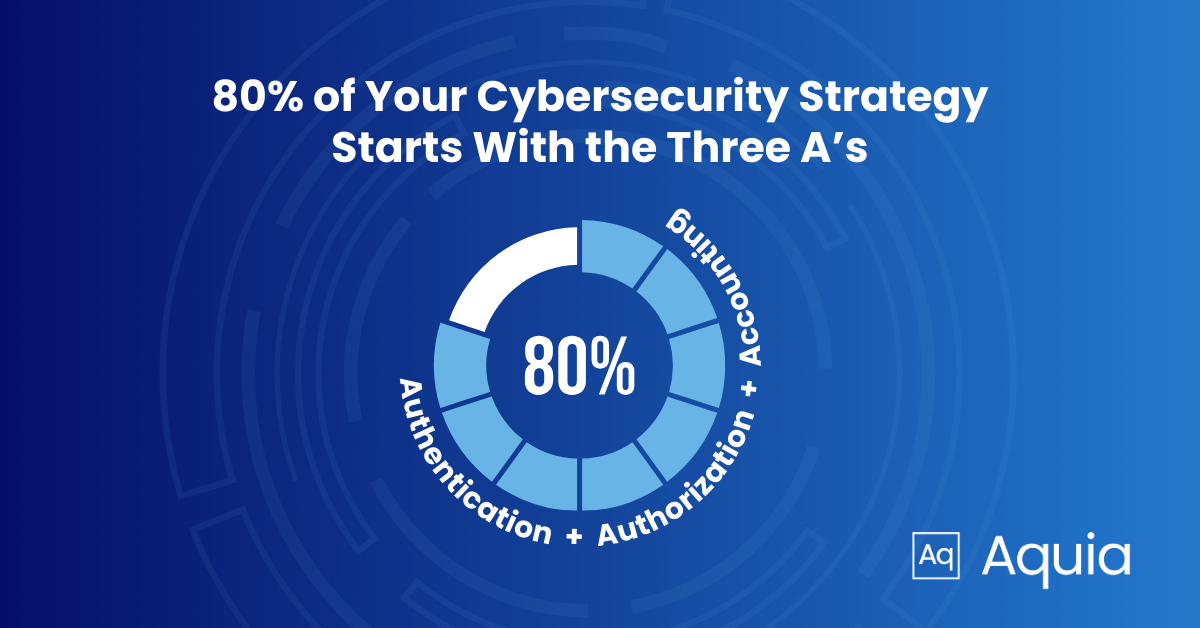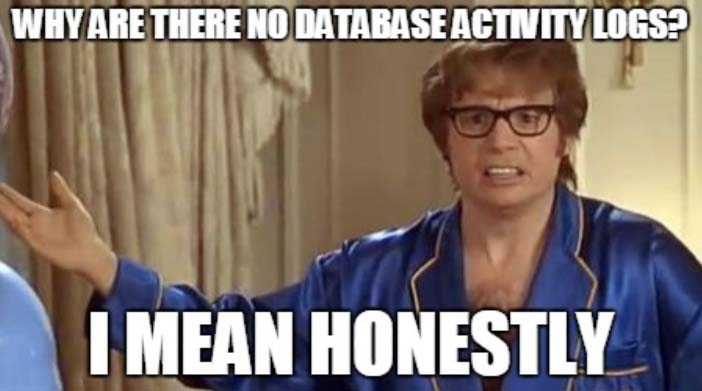Cybersecurity Meets Pareto - The Three A's (AAA)
Authentication, Authorization, and Accounting

A large part of my career has been to help different IT teams understand security and how it applies to their situation, whether they’re in development, networking, databases, or any other type of IT system. Even though “security is everyone’s job,” that doesn’t mean you should expect everyone to be a security expert. I always try to provide ways to support these teams with the least amount of effort. If you’ve ever been part of one of those training sessions, you have heard me mention the three A’s - authentication, authorization, and accounting.
The Pareto Principle, a concept borrowed from economics, states that a large amount of impact comes from a small amount of cause. It’s generally used to explain that “80% of your profit comes from 20% of your customers” and therefore, you should focus on those core customers. Something similar can apply to the field of cybersecurity. This post delves into how applying the Pareto Principle to cybersecurity can establish or enhance protection measures, particularly by concentrating on authentication, authorization, and accounting. If you can do these things right, you’re 80% of the way there.
The "Three As" are just a few of the items covered with our Threat Modeling engagements!
The First A: Authentication - Who Are You?
Authentication, the first element of the AAA framework, is the method in which you verify the identity of users or processes. The strength and complexity of the authentication process are key determinants of a system’s overall security. Ranging from simple passwords to advanced methods like biometrics or digital certificates, authentication mechanisms need to strike a balance between robustness and user convenience. The rise of security breaches has heightened the importance of strong authentication methods, leading to the widespread adoption of multi-factor authentication (MFA). MFA enhances security by requiring multiple proofs of identity, such as a combination of passwords (something the user knows), tokens (something the user has), and biometrics (something the user is). This layered defense approach significantly reduces the risk of unauthorized access.

The Second A: Authorization - What Can You Do?
Authorization, the second key element in the AAA framework, builds on authentication and is the method for defining and enforcing user permissions within a system. Unlike authentication, which verifies identity, authorization determines what resources and actions a user is allowed to access and perform based on their verified identity.
Effective authorization is also designed to enforce the principle of least privilege, ensuring that users have no more access rights than necessary to perform their duties. This important approach minimizes potential security risks by limiting the scope of action for each user. For instance, in a corporate environment, an entry-level employee might have access to basic internal documents, while a manager might have broader access that includes sensitive financial reports.
While many teams implement strong authentication, it’s unfortunately common to keep authorization open and “just let the user access everything” to keep things running. Don’t fall into the trap - take the time to consider how you will manage authorization!
Authorization mechanisms can be implemented in various ways, such as role-based access control (RBAC), where access rights are grouped by role, or attribute-based access control (ABAC), where access is granted based on attributes of the user, the resource, and the current environment. RBAC is simpler and more widely used, offering ease of management by assigning permissions to roles rather than individual users. ABAC provides greater flexibility and fine-grained control, allowing for dynamic permission adjustments based on a variety of factors. Just like everything else, the authentication mechanism that’s right for your system will be contingent on what works best for your organizational needs.
The Third A: Accounting - Who Did What?
Accounting, the third and final pillar in the AAA framework, is sometimes referred to auditing or logging. Accounting is the process of tracking and recording activities within a system, which is crucial for security, compliance, and operational monitoring. Once a user is authenticated and authorized, the accounting phase begins to log their activities, creating a record of who did what, when, and in what context.
This record-keeping is essential for multiple reasons. From a security perspective, it allows for an audit trail in case of security incidents, helping to identify what was accessed or altered during a breach. For example, in a financial system, accounting records could reveal unauthorized transactions or changes to sensitive data, aiding in swift resolution and recovery efforts.
Accounting also supports a variety of operational needs, such as troubleshooting errors, tracking performance, and other useful metrics.
Effective accounting involves not just collecting data but also managing and analyzing it effectively. This may include employing sophisticated log management and analysis tools, which can process large volumes of data to highlight anomalies, trends, and potential security risks. As systems become more complex and regulations more stringent, the role of accounting in the AAA framework becomes increasingly important, ensuring accountability, aiding in security management, and enabling better decision-making.

AAA Examples
Each environment is different and how you implement this is something that should be well thought out. Here are a few specific examples to get you started.
Web Applications
| AAA | Details |
|---|---|
| Authentication | Users typically log in using a username and password. Advanced systems may include two-factor authentication, such as sending a code to the user’s phone or email for additional verification. This ensures that the person accessing the account is indeed the rightful user. In addition, developers should ensure that each piece of the application authenticates (frontend, backend, API, etc.) |
| Authorization | Once logged in, the system determines the user’s access level based on predefined roles. For instance, an ‘admin’ might have full access to all features, including user management and settings, while a ‘user’ might only have read access to content without any editing privileges. |
| Accounting | The system keeps a detailed log of user activities, such as login times, pages accessed, and changes made within the application. This data is crucial for security audits, compliance with regulations, and analyzing user behavior for improvements. |
Cloud Environments
| AAA | Details |
|---|---|
| Authentication | In cloud environments, identity and access management (IAM) systems are used to authenticate users. These generally involve multi-factor authentication (MFA) mechanisms, adding an extra layer of security beyond just username and password. |
| Authorization | Users are granted permissions to access and interact with specific cloud resources based on their roles. For example, a cloud database might only be accessible to users with ‘database administrator’ roles. |
| Accounting | All major cloud providers offer extensive logging capabilities, tracking every action taken by users, such as accessing data, modifying cloud resources, or deploying new services. These logs are critical for security and compliance purposes. |
Enterprise Networks
| AAA | Details |
|---|---|
| Authentication | Employees access the network using secure credentials, often with the addition of security tokens or smart cards for enhanced security. This ensures that only authorized personnel can access the enterprise network and its resources. |
| Authorization | Network access and permissions are managed based on user roles and responsibilities. For example, IT staff may have broader access to the network than other employees, including permissions to manage the network infrastructure. |
| Accounting | The network system logs all user activities, including which files were accessed, any changes made to system settings, and any attempts to access restricted areas. These logs are vital for security monitoring, identifying potential breaches, and ensuring policy compliance. |
Internet of Things (IoT) Devices
| AAA | Details |
|---|---|
| Authentication | Each IoT device, such as a smart thermostat or a security camera, is authenticated when connecting to a network, often using unique credentials or digital certificates to verify its identity. |
| Authorization | The system controls which devices can communicate with each other and with central management platforms. For instance, a home automation system might restrict which devices can control the security system. |
| Accounting | Device activities are logged, including when devices are activated, their operational data, and any communication with other devices or the central system. This information is useful for maintenance, security monitoring, and understanding usage patterns. |
Honorable Mentions - Not AAA, But Just as Important
While authentication, authorization, and accounting form the core of this Pareto-themed cybersecurity implementation “strategy,” there are other elements that I want to call out to go above that 80%.
Vulnerability Management
Vulnerabilities are weaknesses or flaws in a system that can be exploited by cyber attackers to gain unauthorized access or cause harm. Identifying, prioritizing, and addressing vulnerabilities is a key aspect of security management. Proactively managing these vulnerabilities is crucial in safeguarding systems and data from cyberattacks and ensuring the integrity and confidentiality of digital assets.
Supply Chain Management
Understanding where your organization’s hardware and software comes from and what it’s composed of is a critical piece in understanding your true security posture. Aquia’s President, Chris Hughes, is one of the world’s leading experts on supply chain management (SCM) and I highly recommend you check out his blog, Resilient Cyber, or his new book, Software Transparency: Supply Chain Security in an Era of a Software-Driven Society.
Encryption
Encryption has become much easier to implement and is another critical consideration. When you’re designing a system, ensure data is encrypted at the appropriate level for the sensitivity by considering when it’s stored, when it’s being transferred, and when it’s being processed.
Call to Action
Cybersecurity as a whole can be extremely complicated. For smaller organizations or for newer IT professionals, this can be overwhelming. By focusing on the low effort, high impact concepts like AAA, you can make steps in the right direction to create a more secure and resilient digital environment, without overloading the organization. Take the time to consider what makes sense for you. Despite the constant ads and email inbox spam, not every organization needs to buy 100 security tools to protect their digital assets.
How well are the three A’s — authentication, authorization, and accounting — integrated into your cybersecurity strategy? What other key elements would you focus on to reach that 80%? Feel free to share your insights, experiences, or additional tips. Let’s continue to learn and grow together in our quest for a more secure digital world!
If you have any questions, or would like to discuss this topic in more detail, feel free to contact us and we would be happy to schedule some time to chat about how Aquia can help you and your organization.

